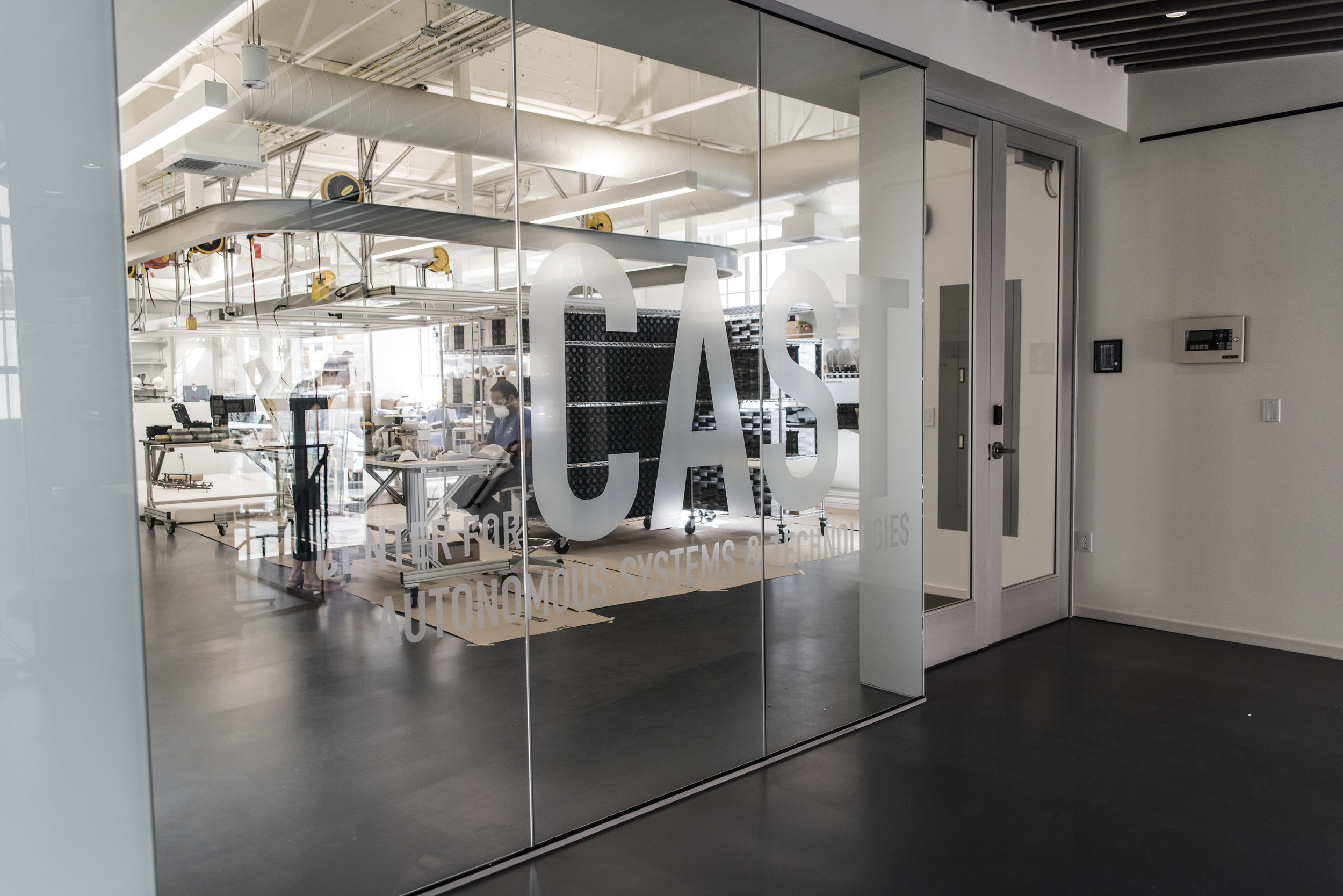Caltech's Center for Autonomous Systems and Technologies
Caltech Launches New Autonomous Systems Research Center
The Center for Autonomous Systems and Technologies (CAST) will unite engineers and scientists from many disciplines to advance research on robotics, drones, driverless cars, and machine learning
On October 24, Caltech will officially open the new Center for Autonomous Systems and Technologies (CAST), a 10,000-square-foot facility where machines and researchers will work together and learn from one another.
At CAST, researchers from Caltech's Division of Engineering and Applied Science (EAS), Division of Geological and Planetary Sciences (GPS), and the Jet Propulsion Laboratory (JPL) will collaborate to create the next generation of autonomous systems, advancing the fields of drone research, autonomous exploration, and bio-inspired systems. Researchers will continue pioneering work on technologies ranging from prosthetic legs that use machine learning to automatically adjust to a wearer's gait to a flying, self-driven ambulance.
"The goal is to teach autonomous systems to think independently and react accordingly, preparing them for the rigors of the world outside of the lab," says CAST Director Mory Gharib, Hans W. Liepmann Professor of Aeronautics and Bioinspired Engineering.
The facility will be a living experiment. While engineers construct and test drones, robots within CAST itself will learn to help run the facility—all while being observed by 46 cameras that provide complete coverage of the interior, tracking each robot's motion down to within 100 microns (about the thickness of a human hair).
The CAST team includes more than two dozen engineers and scientists. Instead of developing autonomous systems simply for the sake of advancing the technology, the work will be guided in part by scientists and other stakeholders who would benefit tremendously from autonomous systems. For example, by collaborating with seismologists and first responders, engineers could develop a swarm of flying sentinel drones that automatically activate during an earthquake, rapidly scan damaged areas, and relay information about where there are likely to be injured people in need of medical attention. "The CAST team will also work on the next generation of drones and robots to explore the solar system, including submersible vehicles designed to operate in the ice-covered oceans of Europa, a moon of Jupiter," says CAST steering committee member Woody Fischer, Professor of Geobiology.
The facility will include an assembly room with an 85-foot-long oval track for walking robots and an aerospace robotics control lab with high-precision flat floor that allows researchers to fly "spacecraft" that have been engineered to hover through high-pressure jets (like a reverse air hockey table) and simulate the frictionless motion of space flight. But CAST's centerpiece is a three-story-tall, wholly enclosed aerodrome—the tallest of its kind—in which to test flying drones. To simulate the ever-shifting environmental conditions that drones face in the real world, the aerodrome includes a 10-foot-by-10-foot wall of 1,296 fans capable of generating wind speeds of up to 44 mph, with a side wall of 324 fans to create a crosswind. The wall is capable of creating a nearly infinite variety of wind conditions for drones to learn to react to—everything from a light gust to a stormy vortex. It can also be tilted 90 degrees to simulate vertical take offs and landings.
"The current state-of-the-art in autonomous systems is very promising on two divergent fronts," Gharib says. "The bodies, or machines and sensors, have become more and more sophisticated and capable. Meanwhile, the algorithms that collect and interpret behavior are increasingly fine-tuned. We plan to bring these two together through a series of 'moonshot' challenges that we will undertake in the coming years."
Like their ambitious namesake that challenged Americans to send a human to the moon in the 1960s, CAST's moonshot goals will require advances in engineering to accomplish feats not yet possible. They include building a robot (guided by a network of flying drone scouts) that can walk from Mexico to Canada without assistance and creating a drone delivery service between Caltech and JPL.
One key goal of CAST is the development of an autonomous flying ambulance for urban applications. Flying vehicles offer significant benefits over their ground-based counterparts: three-dimensional space is easier to navigate safely than two-dimensional space, and there is an advantage to rising above the gridlock that, with 60 percent of the world's populations expected to live in cities by 2030, will only continue to get worse.
"This isn't just as simple as creating a UAV big enough to carry a person. You need a fault-tolerant vehicle that can adapt autonomously to shifting weather conditions and navigate through skies without colliding with other UAVs. You need the best in aerospace engineering, machine learning, GPS-free navigation—and all of it scalable," Gharib says. "It's a huge challenge, but at CAST, we can and will build it."
Corporations and industry members will play a key part in the development of CAST technologies and systems. With the lead sponsorship of Raytheon Company as well as the support of corporations such as AeroVironment, industry partnerships will help fund CAST and the development of the next generations of autonomous systems. Through these partnerships and collaborations, industry members will assist CAST researchers in bringing the resulting products to market faster.
This endowed center was established through the generous support of Foster and Coco Stanback. More information about the CAST facility can be found online at http://cast.caltech.edu.
Written by Robert Perkins

